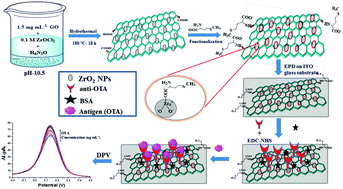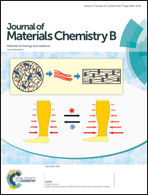Amino acid functionalized ZrO2 nanoparticles decorated reduced graphene oxide based immunosensor†
Abstract
Here, a study is reported on a simple, one-step method for the synthesis of a zirconium dioxide–reduced graphene oxide (ZrO2–RGO) nanocomposite involving the reduction of graphene oxide (GO) and in situ growth of ZrO2 NPs using hydrazine as a reducer. This ZrO2–RGO nanocomposite was functionalized with L-methionine (Meth) for immunosensor application. Morphological and structural studies clearly indicated that ZrO2 NPs (6 nm) were decorated onto the RGO sheets, and enhanced exfoliation, thereby preventing the restacking of the RGO sheets. RGO improved the electrochemical properties of the ZrO2–RGO nanocomposite and minimized the aggregation of ZrO2 NPs. FTIR studies confirmed the functionalization of the ZrO2–RGO nanocomposite with Meth and biomolecules (anti-OTA and BSA). The Meth functionalized ZrO2–RGO nanocomposite had enhanced biocompatibility and wettability as confirmed by MTT assay and contact angle studies, respectively. Furthermore, a uniform thin film of the Meth/ZrO2–RGO nanocomposite was electrophoretically deposited onto an indium tin oxide (ITO) coated glass substrate and utilized for covalent immobilization of monoclonal antibodies specific to ochratoxin A (anti-OTA) for the detection of ochratoxin A (OTA). The fabricated BSA/anti-OTA/Meth/ZrO2–RGO/ITO immunoelectrode exhibited a wide linear detection range of 1–20 ng mL−1 with a sensitivity of 4.8 μA ng−1 mL cm−2 and a detection limit of 0.079 ng mL−1 for OTA detection.



 Please wait while we load your content...
Please wait while we load your content...